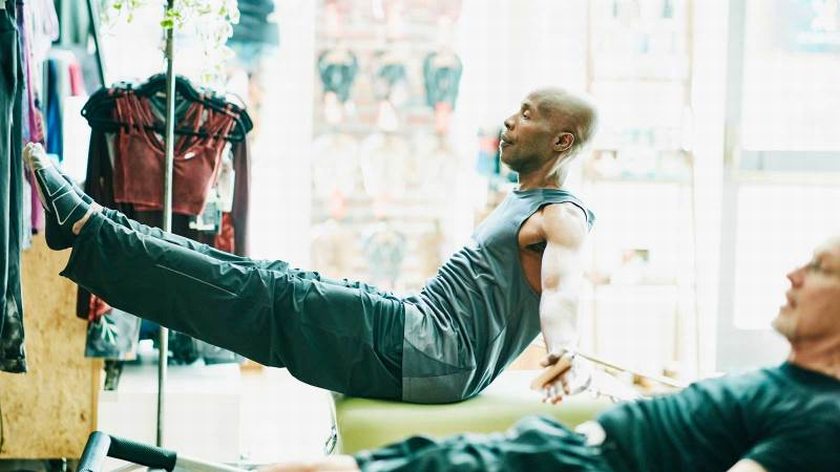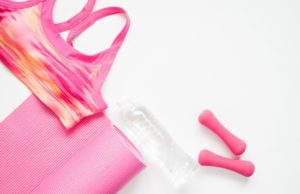It’s time to stop scoffing at Pilates. While the workout—which focuses on building core strength, mobility, flexibility, and strength—seems to be primarily loved by women, it was actually created by a man—a German bodybuilder at that. And today some of the fittest men on the planet (i.e. Navy SEALs) turn to the discipline to counteract their weaknesses and become more well-rounded athletes.
“When you’re out on a site somewhere, you can’t just pop into the gym and get your workout in,” says Keely Watson, owner of 11 Club Pilates studios in the San Diego area who trains multiple Navy SEALs. “You have to be able to do a lot of bodyweight exercises and use what you have available to stay in peak physical condition.”
While reformers are pinnacle to Pilates, most of the work done on a Pilates machine can be replicated on a mat.)
Will Beale, a U.S. Navy veteran, says his days of lifting heavy weights are over—and swears by Pilates for full-body work.
“The emphasis that it places on the core creates a solid foundation from which the whole body can benefit.”
Here, three reasons the fittest of the fit love the workout—and how even gym rats can benefit from a Pilates practice.
It’s a Solid Supplement to Other Workouts
If your fitness routine consists of cardio and strength training, that’s fine. And that’s exactly why most men are drawn to Pilates: It’s different.
“The guys we get in class end up being long-term clients because they realize the benefits are so different than what they’re getting from CrossFit, going to the gym, or running,” says Watson.
To this extent, Pilates also complements other activities such as golfing or cycling. A recent study published in PLOS One even found that 12 weeks of Pilates improved people’s 5K times, perhaps by strengthening postural muscles and improving motor functions.
Beales, who now owns a Club Pilates in Washington, D.C., utilizes it in addition to his cycling.
“Cycling is great for cardio and endurance, but it can put stress on the spine, neck, shoulders, arms, and legs.”
Even if you don’t cycle, some research finds Pilates can work to counterbalance a forward head tilt (something anyone who texts or hunches over a computer on a regular basis might suffer from).
It Builds Longevity, Flexibility, and Prevents Injury
“No pain, no gain” isn’t a great fitness motto for longevity. For those who push themselves past their limits more often than not, Pilates can be a respite from high-impact work.
“You’re able to incorporate something into your routine you can do for years and years,” says Watson.
Even more: While heavy lifting can build strength, it doesn’t do much for flexibility, notes Beales.
“Pilates offers movements that entail full range of motion, strengthening your joints and ligaments, increasing flexibility, and providing stability in the pelvic and hip regions.”
This all works to prevent injury, he says. In fact, many of the SEALs Watson trains see the workout as a means to protect their bodies.
“They can’t be sidelined with a sore back or a torn rotator cuff if they have to do something extreme with their body,” he says. “That’s not a good combination. Working smaller stabilizer muscles can keep the body working as a whole, she notes.
It’s Hard
Pilates can come as a bit of a shock at first.
“We can do very small movements on what doesn’t feel like a lot of weight,” says Watson. But if you’re doing the moves the right way, you’ll be shaking and struggling with the best of them.
See for yourself by trying these four moves from Watson. Complete 8 to 10 reps of each move, but focus more on doing the exercises with control rather than pumping out reps.
“Our bodies are designed to work with the path of least resistance,” says Watson. “You want to retrain the way your body moves so that you’re moving correctly biomechanically and in a healthy way.”
1. Chest Lift
Lie on your back with knees bent, feet flat, and hands behind head. Make sure your pelvis is in a neutral position (you should have a small space under your low back). Pull your ribs down and together, lifting your head, neck, and shoulders several inches off floor. Lower back down.
2. Chest Expansion
Kneel facing the back of the Pilates reformer on the carriage. Knees should be at the shoulder rests for stability. Hold straps with arms extended long down by your sides, reaching past hips. Press your hands about 3 to 4 inches behind your body. Keep your chest open and collarbone wide. Bring your hands forward to where you’ve still got tension, usually in line with your hips, then press back again.
3. External Shoulder Rotation
Kneel facing sideways on the reformer carriage with one leg against the shoulder rests for stability. Hold a loop or handle in the hand farthest from the shoulder blocks. Hold your arm at a right angle, elbow near waist, thumb facing toward the ceiling. Without allowing your elbow to move away from your body, rotate your arm outward, away from your torso, as far as possible, while maintaining proper wrist alignment and a 90-degree angle in your elbow. Slowly bring your arm back to the starting position, resisting spring tension. Repeat on other side.
4. Back Extension on the Long Box
Lie on your back on the long box on top of the reformer carriage, facing the risers at the back of the machine. Hold tape above clips on the reformer ropes and bring your hands in line under your shoulders. Engage your core, pulling your belly button up off the box, extending through your legs and reaching your toes long to engage your hamstrings and glutes. Slowly pull your hands up in line with your hips, reaching back toward your feet, broadening your collarbone and pulling your shoulder blades together. Maintain alignment of your neck with the rest of your spine and gaze down. Slowly lower your arms back to the starting position, maintaining tension on the ropes.
For access to exclusive gear videos, celebrity interviews, and more, subscribe on YouTube!











